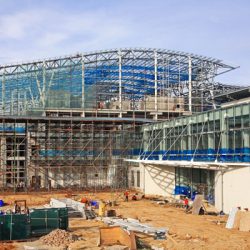Royalty swings by ‘favourite airport’ to open extension building
Her Royal Highness The Duchess of Rothesay took time out of her busy schedule to unveil the plaque on an upgrade to Scotland's third largest airport
List view / Grid view


The role of an airport is to facilitate a journey to a desired destination, however, many airports are endeavouring to become destinations in themselves. To achieve this demands new designs and innovative features which can provide a ‘wow factor’ for passengers, allowing airports to not only cope with growth, but excel.
Already we have seen inspiring applications of innovative design within the industry. In this section of International Airport Review’s website, we will showcase examples of creative construction and design, and keep you up to date with project progress around the world.
Her Royal Highness The Duchess of Rothesay took time out of her busy schedule to unveil the plaque on an upgrade to Scotland's third largest airport
The airport is the first civilian airport to be built since the country was founded in 1948 and will eventually serve the Red Sea resort of Eilat and Israel's southern region when it opens to the general public in early 2018.
Concessionaire Analyzer+ (CA+), the leading solution globally in airport non-aeronautical revenue management, has extended the property management functionality of CA+ to include Space Management.
Politicians from all major political parties took part in the extracurricular battle for hearts and minds that was the Tegel campaign. But was it worth it?
Australia's third busiest airport is set to share tips with China's ninth as the ink dries on a new sister pact to go with their cities' 10-year partnership.
ACI Europe say that without funding the project and its inclusive goals will struggle to be realised.
In the race of aviation tech there are more and more runners each year. Britain is falling behind according to aerospace expert Iain Gray, and it is of the utmost importance that it makes great strides to keep pace.
The check-in hall at Malta International Airport is undergoing a reorganisation as part of its ongoing €12 million Terminal Reconfiguration Project.
Last year, Changi Airport saw 58 million passengers pass through its doors. With the opening of Terminal 4 at the end of October, this number could climb by as much as 25 per cent - putting the city state's largest airport easily within the world's top-ten largest.
Gudmund Stokke, Founding Partner of Nordic – Office of Architecture, provides details of the construction and design elements of the new terminal at Oslo Airport which has set new standards in airport sustainability.
Nancy Knipp, Senior Vice President at Airport Lounge Development explores the reasons behind the rise of the shared airport lounge in the United States.
Colleagues Rogier Doffegnies, Alex Jansen and Gé Smit from 2ndSense AirportCreators delve deeper into the changing world of airport development.
International airports of all sizes can and should expect the same level of support, customisation and savings from their software provider. Quantum Aviation CEO David Kennedy explains why.
Read Issue #5 of International Airport Review: Includes in-depth focuses on Security, Ground Handling and ATC/ATM, with articles covering airport development, airport collaborative decision making and how Dallas Fort Worth is using cargo to increase their revenue...
Edinburgh Airport will soon be equipped to deal with record passenger numbers as construction starts on a new extension to its terminal building.